Magna Via Francigena
- 3 Days
- Availability: all year long
- Gravel or urban e-bike: choose your route
Magna via Francigena
Description
The Magna Via Francigena, one of the most important historical streets in Sicily, was once a Roman road until it became the fulcrum of the Norman road system, which mainly develops on dirt roads and partly on low-traffic paved roads.
With this itinerary of just over 200 km you will travel Sicily from sea to sea, in 3 stages; thus discovering the most authentic Sicily.
Itinerary
The itinerary starts from Palermo, the capital of Sicily, a city rich in history, with an exceptional artistic and architectural heritage such as the Norman Palace with the Palatine Chapel, the Teatro Massimo, the Cathedral of Palermo and the historical markets such as the Mercato Ballarò and the Mercato Vucciria.
You will cross Monreale, declared a UNESCO World Heritage Site in 2015, in recognition of its historical and artistic importance. The village is one of the most fascinating places to visit in Sicily. Its Cathedral, known as the Cathedral of Monreale, is one of the best examples of Norman architecture in Sicily and is famous for its breathtaking shining mosaics. These mosaics cover the entire interior of the church and represent biblical stories and religious scenes with an extraordinary wealth of details.
The last part will lead to Corleone, a town in the Sicilian hinterland whose fame began when his name was linked to the Mafia family in the saga of “The Godfather” movies directed by Francis Ford Coppola. The city has a complex history and a rich culture beyond the stereotypes related to the mafia.
Leaving Corleone, the path will take you through fascinating Sicilian rural landscapes, hills, cultivated fields and small villages. The first town you will cross is Prizzi where you can admire its beautiful castle built in 745, when Sicily, which was under Byzantine rule, was threatened by Muslim raids. The Byzantines then decided to protect themselves from the imminent attack of the Muslims, building castles and fortresses to defend their homes.
Continuing along the route you will cross the nature reserve Monte Carcaci, a protected Natural Area located in the municipalities of Prizzi and Castronovo di Sicilia. The latter is characterized by a precious element: water. One of the springs of Platani was born in Castronovo and, much of the history and economy of the territory, have crossed this important river. Despite its three thousand inhabitants, the territory of Castronovo is among the largest in Sicily. Here you can admire its many churches, in particular the Church of San Vitale, the caves and the Casale di San Pietro.
Along the way, you will then reach Mount Cammarata, with breathtaking views of the surrounding countryside, San Giovanni Gemini and Acquaviva Platani.
The second stage ends in Sutera, a pretty Sicilian hilltop town. This town is famous for its troglodyte dwellings carved into the rock and for its medieval architecture. Of great interest are the Chiesa Madre di Santa Maria La Cava and the typical rock dwellings.
The last section of the Magna Via Francigena starts from Sutera and leads, after about 75 km, to Agrigento.
The route will take you through the Sicilian countryside, among olive groves, vineyards, and breathtaking hilly landscapes starting from the picturesque hills surrounding Campofranco. The latter is a small town characterized by its quiet atmosphere and the beauty of the surrounding hills. His name “Campofranco” derives from the Latin language and means “free field”. The city has an ancient history and has seen the influence of several civilizations over the centuries, including the Romans and Arabs.
Later you will reach Racalmuto, the birthplace of Leonardo Sciascia, in 1921; Comiti, a city known because holds sulfur mines that were active in the nineteenth and twentieth centuries as an important part of the mining industry of Sicily; and Aragon a city of Roman times, whose current name derives from the feudal lords Aragon, a Spanish noble family that ruled the city in the fifteenth century. Throughout its history, Aragon was influenced by several civilizations, including the Romans, Byzantines, Arabs and Spaniards.
The final destination of the Magna Via Francigena, Agrigento, is famous worldwide for the Valley of the Temples, an archaeological site containing well-preserved ancient Greek temples.
Richiedi gratuitamente la traccia.
- Possiamo aiutarti ad organizzare il tuo viaggio, seleziona i servizi di cui hai bisogno.

